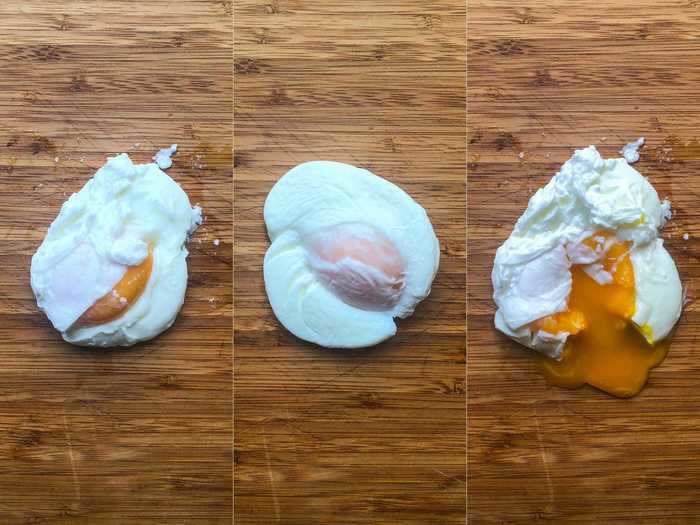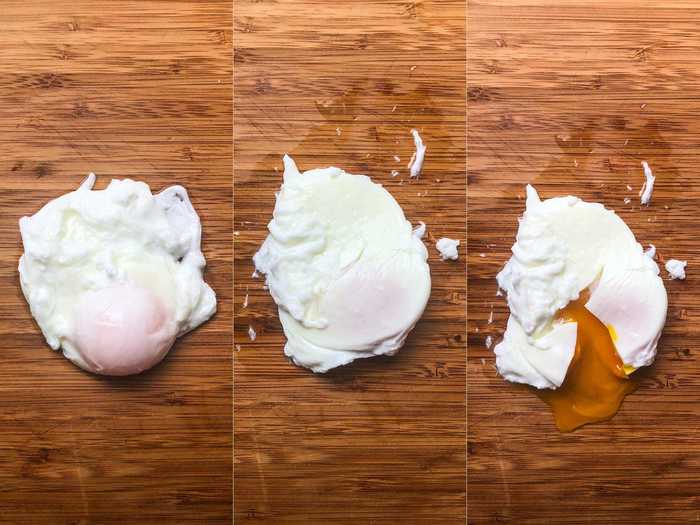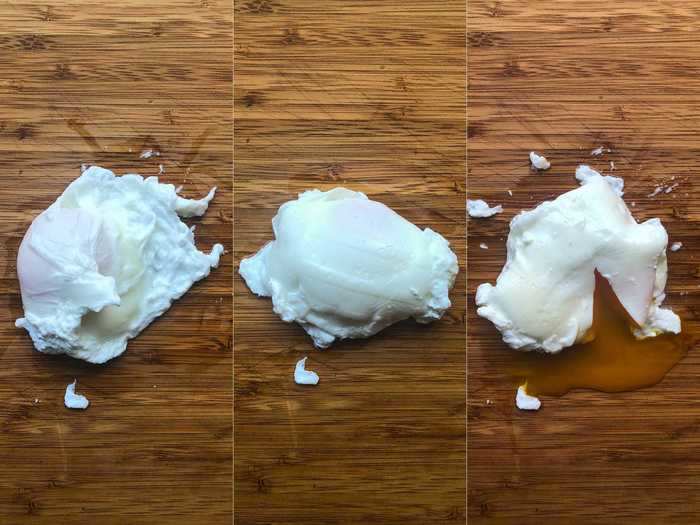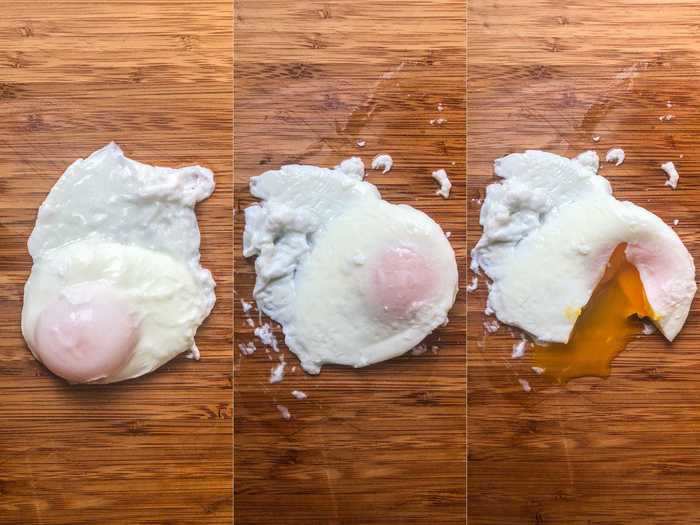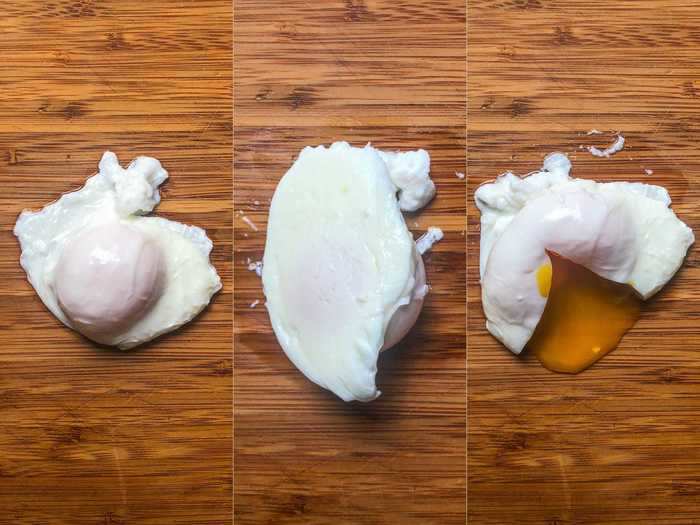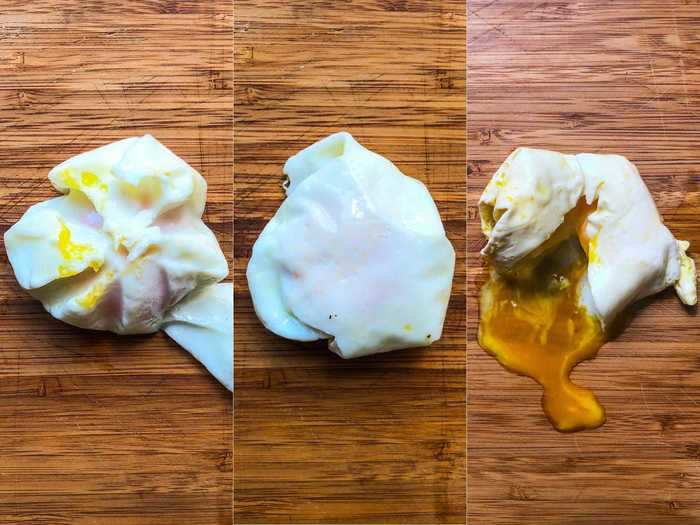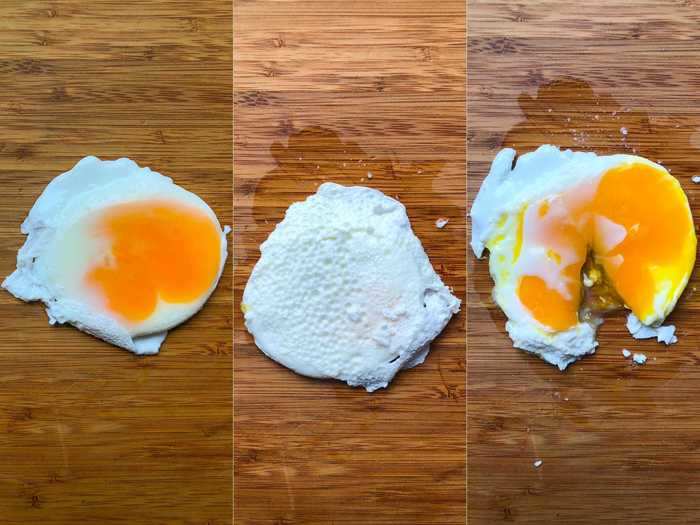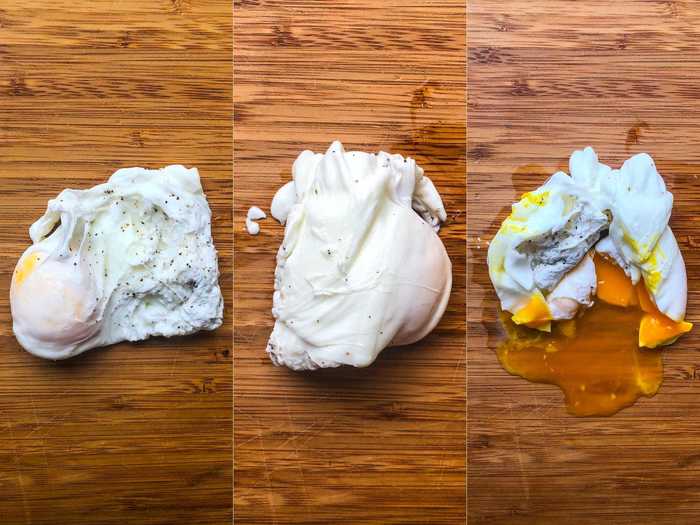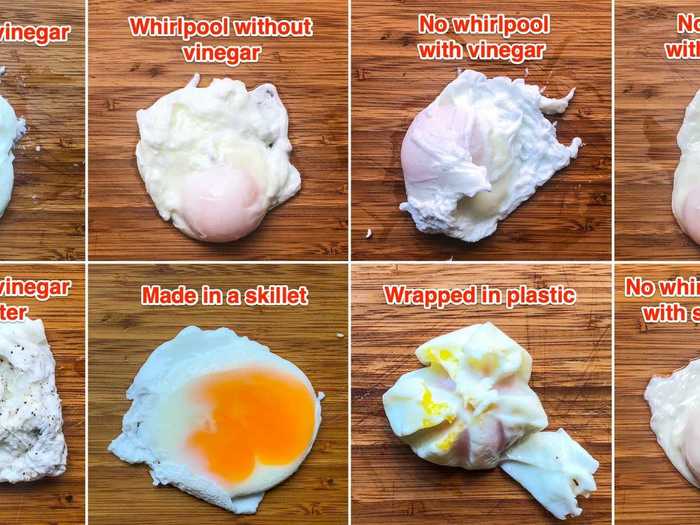Insider
- I made poached eggs eight different ways to discover which made the most perfect brunch item.
- I wanted to find out whether common tips like adding vinegar to the water, making a whirlpool, or straining the raw egg actually make a difference.
- Making a whirlpool with the water is supposed to wrap the white around the yolk, though I found that wasn't the case every time.
- I did find that straining the egg minimized stray bits of white known as wisps that form in the pot.
Unlike scrambled or hard-boiled eggs, poached eggs exude both elegance and versatility.
They can be found on top of English muffins dripping with hollandaise for eggs Benedict, nestled into a green frisée salad, oozing over a bowl of carbonara, or served atop avocado toast.
In learning how to make a brunch-worthy poached egg, I referenced a multitude of cooking methods recommended by chefs and home cooks alike. I narrowed down a list of eight hacks to try while using a simple Food Network recipe — which calls for cooking the egg for five minutes in a covered pan of boiling water taken off the heat — as my starting point.
Using large eggs straight from the refrigerator (unless otherwise specified), I made changes to each batch such as employing the whirlpool method, using one tablespoon of white vinegar, and straining excess egg whites. I also tried a couple of celebrity chef-approved methods.
Using a whirlpool and adding vinegar kept the egg in one tight pouch while poaching.
The top (left), bottom (center), and broken yolk (right) of an egg poached in a whirlpool with vinegar.
Rachel Askinasi/Insider
The egg sat like a nice little pouch at the bottom of the pot immediately after I dropped it into the center of the whirlpool. Most of the white was neatly enveloping the yolk with just a few loose and wispy bits of white at the top.
Removing the egg with a slotted spoon, I saw that the white had pulled away from the yolk a bit on the bottom. The shape was more of a broken blob than a cohesive dollop, which is less than ideal if you're looking for beautiful presentation.
Cutting into the finished egg, both the yolk and white were cooked well. The yolk had a velvety texture and the white was firm, though its edges were a bit rubbery. I wasn't able to taste the added vinegar here.
Without vinegar, the whirlpool didn't seem to have the same wrapping effect.
The top (left), bottom (center), and broken yolk (right) of an egg poached in a whirlpool without vinegar.
Rachel Askinasi/Insider
The white of this egg feathered as soon as I added it to the pot of water and retained their wide shape throughout cooking. Some wispy bits of egg white detached from the egg and got left behind in the pot.
This definitely wasn't a pretty poach — the top showed a raw, goopy white and the bottom was flat.
Upon cutting into the egg, the yolk, which was cooked well and had a velvety mouthfeel, had detached in some places from the mostly undercooked white.
The egg tasted saltier than the one made similarly but with vinegar.
Using vinegar but no whirlpool, I saw some feathering in the pot, though it self-corrected quickly.
The top (left), bottom (center), and broken yolk (right) of an egg poached in still water with vinegar.
Rachel Askinasi/Insider
There was some heavy feathering when I first placed the egg in the pot, but within seconds the whites came together on their own.
From the top, I could see that the outer white was cooked but the white closest to the yolk were still raw when I lifted the egg from its bath. The underside looked beautiful and ready to serve on top of toast, though.
The yolk broke perfectly and I couldn't tell that there were runny whites while I was eating it.
I wasn't able to taste the vinegar at all in this egg either.
Dropping the egg without a whirlpool or vinegar also caused the feathering of egg white.
The top (left), bottom (center), and broken yolk (right) of an egg poached in still water without vinegar.
Rachel Askinasi/Insider
The egg white spread wide across the bottom of the pot, though it stayed completely intact, which meant the water was egg-free once I removed the pouch.
I could see before removing the egg that the yolk was round and pronounced rather than wrapped in the white. It stayed protruding when I lifted it from the water, which meant I could only serve it yolk up.
While both components were perfectly cooked, this hardly looked like something worthy of a perch atop avocado toast.
Without added vinegar, the flavor here was salt-forward.
Using a strainer instead of the whirlpool and vinegar method kept feathering to a minimum, but didn't produce a pretty egg.
The top (left), bottom (center), and broken yolk (right) of an egg poached after straining out loose whites.
Rachel Askinasi/Insider
For this method, I cracked an egg into a fine-mesh sieve and let the loose whites drip through into a dish. I placed what was left — the yolk and its surrounding thicker sack of white — into still water.
While feathering was kept to a minimum, the yolk rose to the top of the white pouch and resembled a sunny-side-up egg in shape. The underside was completely flat.
The yolk was decadent and the white was soft but not rubbery. Both components came together as one cohesive egg rather than separating. Everything was cooked perfectly, but the presentation was less than stellar and the flavor was salty.
Using Chef Jamie Oliver's plastic pouch method gave me a beautifully shaped egg that cooked perfectly.
The top (left), bottom (center), and broken yolk (right) of an egg poached in plastic wrapping.
Rachel Askinasi/Insider
Personally, I wouldn't choose to cook anything in plastic. But this method from celebrity chef Jamie Oliver — which involved putting the egg in an oil-lined, plastic-wrap parcel and dropping it into the water — promised an easy way to make multiple poached eggs at once, and it delivered.
It was a lot of work to make sure the plastic was secure enough, but once I had my egg in its oiled pouch, it poached beautifully in three minutes and looked good on top of my toast.
The white was completely cooked through but remained soft, and the yolk was thick but runny.
The most uneven cook of them all came from when I tried to poach an egg in a deep skillet.
The top (left), bottom (center), and broken yolk (right) of an egg poached in a skillet.
Rachel Askinasi/Insider
While there was no feathering with this version of poaching, the egg flattened out and stuck to the bottom of the pan. The sticking seemed to cause air bubbles to form on the bottom of the egg, making it less visually appealing.
The yolk and white closest to the bottom were cooked, but the top was raw and gooey even after letting it poach longer than the recommended five minutes.
A noticeable vinegary film was left on my teeth after tasting this egg.
Chef Gordon Ramsay's method cooked the egg perfectly, but mine wasn't as beautiful as his.
The top (left), bottom (center), and broken yolk (right) of an egg poached in a whirlpool of boiling water and vinegar.
Rachel Askinasi/Insider
Ramsay recommends cracking a room-temperature egg directly into a fast-moving whirlpool of boiling water.
There was minimal feathering of the egg white when I dropped this egg into the boiling whirlpool. Though it stayed intact, the moving water didn't form the egg into a pouch as Ramsay suggested it would. Instead of wrapping around the yolk, most of the white rose to the top of the water.
The "MasterChef" judge recommended a cook time of between 90 seconds and two minutes. I removed my egg at 90 seconds and the whites were done perfectly, but I think the yolk could have used another 10 seconds in the water — it was more wet than velvety in texture.
Ramsay recommended seasoning the water with salt, pepper, and vinegar, which made for a delicious flavor.
Poaching an egg requires a lot of attention to detail and, in my experience, a tablespoon of vinegar.
Each alteration made a difference in how the eggs looked.
Rachel Askinasi/Insider
After trying to make these eggs eight different ways, I still haven't mastered the art of a perfectly cooked, beautiful poached egg.
I did, however, learn that using vinegar helps to reduce feathering, a small pot is better to use than a pan, and straining away the loose whites does nothing but make your brunch smaller.
While I do recommend using vinegar to cut the saltiness and keep the white together, the closest I got to a perfect poach was employing the whirlpool and forgoing the vinegar.

